“Deaf and Dumb Land cannot hear its own voice, but it can speak”
By H Dominic W Stiles, on 2 October 2015
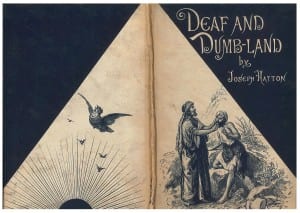 Deaf and Dumb Land is the catchy title of a short booklet by the author and journalist Joseph Hatton (1841-1907)*, formerly editor of The Sunday Times. It describes Hatton’s visit to the Margate School, then under Richard Elliott and using the ‘oral’ method of education. Published in 1896, the book is rather typically Victorian in its mawkish journalese –
Deaf and Dumb Land is the catchy title of a short booklet by the author and journalist Joseph Hatton (1841-1907)*, formerly editor of The Sunday Times. It describes Hatton’s visit to the Margate School, then under Richard Elliott and using the ‘oral’ method of education. Published in 1896, the book is rather typically Victorian in its mawkish journalese –
A World of Silence. No sound, not a whisper. Cut off from music, from the murmurings of the brook, the sighing of the sea, the song of birds, the swelling anthem, the loving tones of a mother’s voice, the pomp of martial strains, the “rustling of proud bannerfolds,” the “peal of stirring drums.”
Born into a world of stillness, and yet to learn that you are surrounded by the “harmonius discord” of busy multitudes, by the chiming of “sad church bells,” the clash of festal peals, the patter of summer rain, the roaring of the wind; the voice of God Himself, as even the savage hears it in the tempest and in the thunder.
To be born speechless too! (Hatton, 1896 p.1)
I will spare you more but I think you will get the idea of his ‘florid’ prose.
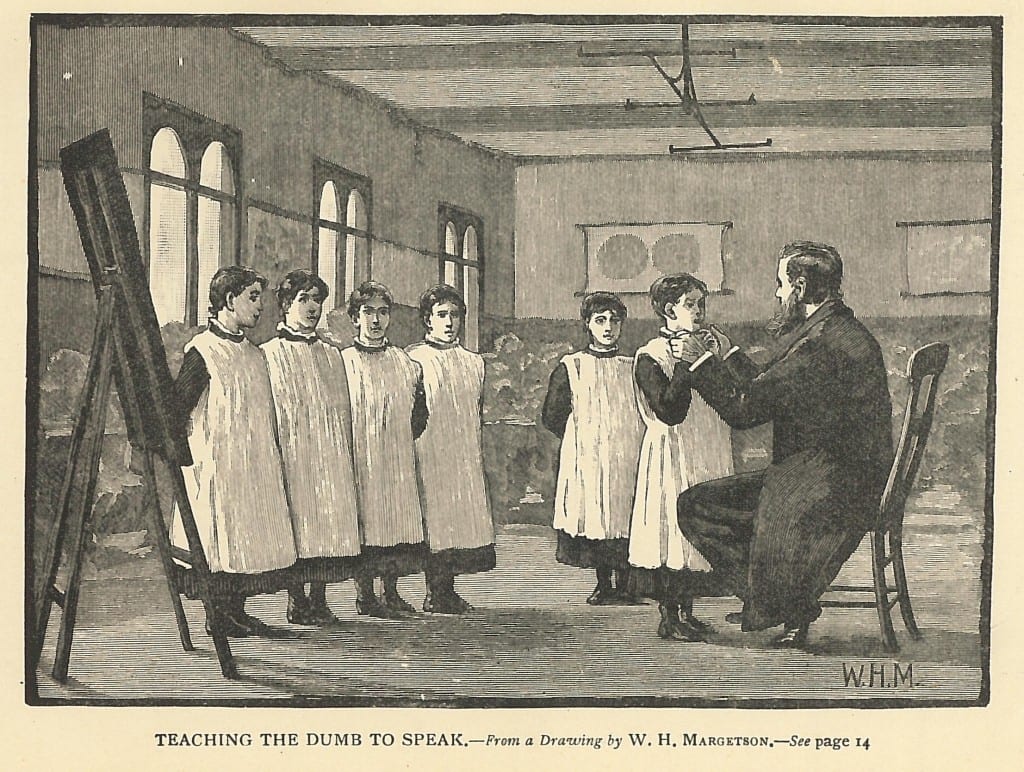 There seems to be a definite ‘oralist’ agenda in the book. Was his visit at the urging of an oralist, or out of his own interest? I think it possible that a researcher might be able to uncover Hatton’s motives. He says that “Into this universal stillness of Deaf-and-Dumb-Land has shone the light of a great hope […] Deaf-and-Dumb-Land cannot hear its own voice, but it can speak, and with no uncertain voice.” (p.6 and p.7) All thanks to the teaching methods we see illustrated here, from the booklet. Young girls who are probably about seven, the age of admission (p.15), are seen here with Richard Elliott, long time teacher and then head teacher at the school, and a convert to oralism.
There seems to be a definite ‘oralist’ agenda in the book. Was his visit at the urging of an oralist, or out of his own interest? I think it possible that a researcher might be able to uncover Hatton’s motives. He says that “Into this universal stillness of Deaf-and-Dumb-Land has shone the light of a great hope […] Deaf-and-Dumb-Land cannot hear its own voice, but it can speak, and with no uncertain voice.” (p.6 and p.7) All thanks to the teaching methods we see illustrated here, from the booklet. Young girls who are probably about seven, the age of admission (p.15), are seen here with Richard Elliott, long time teacher and then head teacher at the school, and a convert to oralism.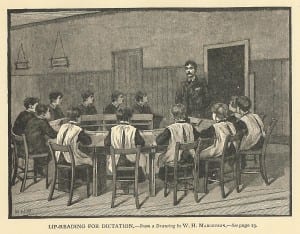 “Five years of careful work has demonstrated the fact that a considerable percentage of the dumb can be made to speak. […] Hitherto he could only talk by signs.” (p.12)
“Five years of careful work has demonstrated the fact that a considerable percentage of the dumb can be made to speak. […] Hitherto he could only talk by signs.” (p.12)
This picture shows children ‘lip-reading for dictation’, and in true Victorian style, the teacher has a luxuriant moustache, which cannot have helped. “There must be no slovenliness in his articulation.” (p.25) The dictation was a poem, part of which goes as follows –
“Little drops of rain;
Where do you come from,
You little drops of rain?
Pitter, patter, pitter, patter,
On the window pane.”
(p.26)
The next picture by the author’s wife shows a ‘lesson in articulation’. He says “The first efforts are directed to the teaching of articulation, the utterance of sounds, some of which have no meaning, and are only useful later on in the pronunciation words which have.” (p.18) “In the second class the words represented actions.” (p.19) Hatton tells us that for teaching they used an illustrated volume produced by the Asylum “thirty years ago” (p.19-20).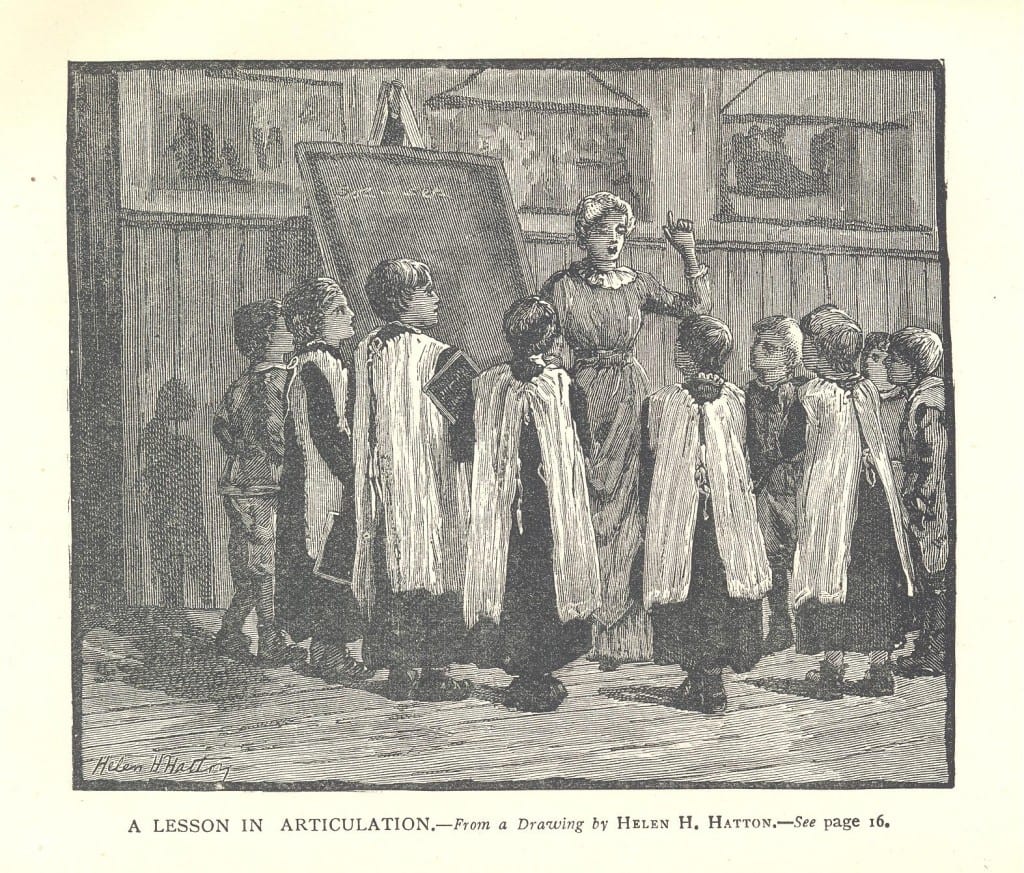
At the time of his visit, the school had still got a branch in Ramsgate, “shortly to be vacated” (p.17), in addition to the main part in Margate. Of additional interest, Hatton mentions that the “offices of the Asylum for the support and education of Indigent Deaf and Dumb Children are at 93, Cannon Street, opposite the station of the South Eastern Railway Company.”(p.42) Astute readers will recall that this has featured before in the blogg.
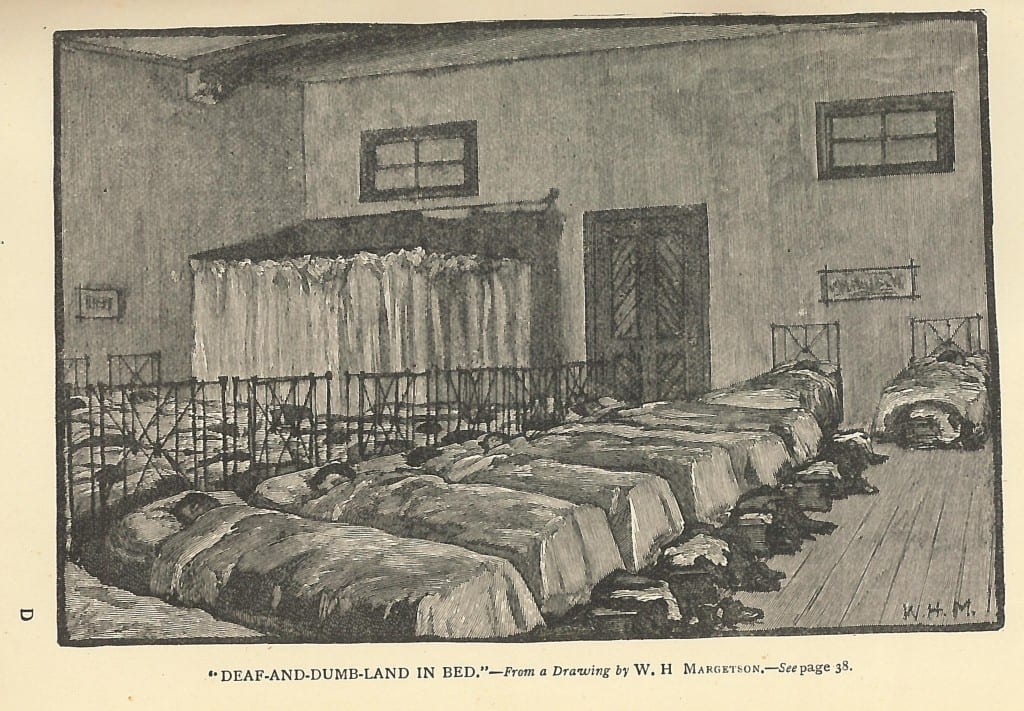 Hatton, Joseph, Deaf–and–Dumb Land, etc. [An account of the Ramsgate and Margate branches of the Asylum for the Deaf and Dumb in the Old Kent Road.]
Hatton, Joseph, Deaf–and–Dumb Land, etc. [An account of the Ramsgate and Margate branches of the Asylum for the Deaf and Dumb in the Old Kent Road.]
Joseph Hatton, 1841-1907, London : Asylum for the Deaf & Dumb, 1896
Andrew Sanders, ‘Hatton, Joseph Paul Christopher (1841–1907)’, Oxford Dictionary of National Biography, Oxford University Press, 2004 [http://www.oxforddnb.com/view/article/33758 accessed 2 Oct 2015]
*I follow the DNB dates rather than Wikipedia’s date of his birth as 1837.
 Close
Close

